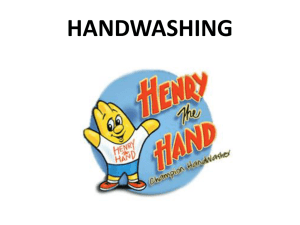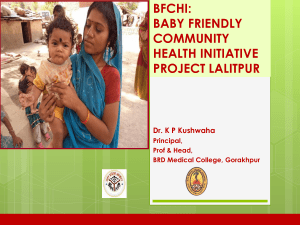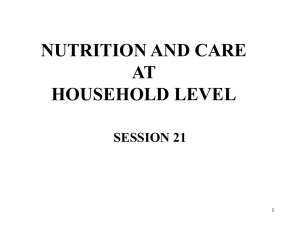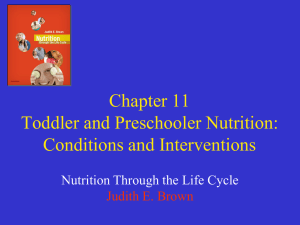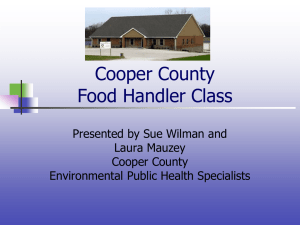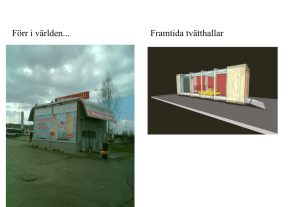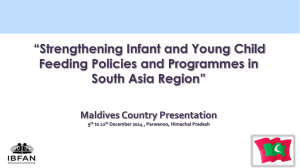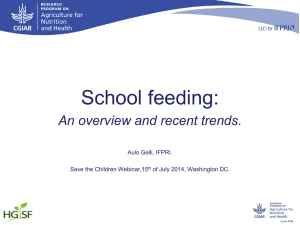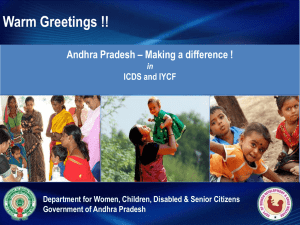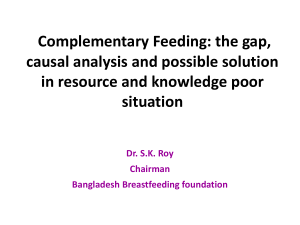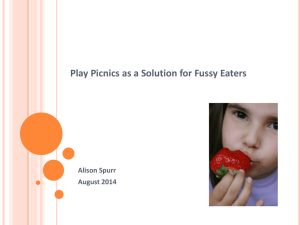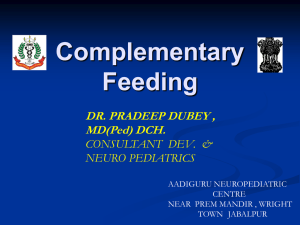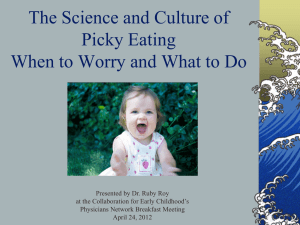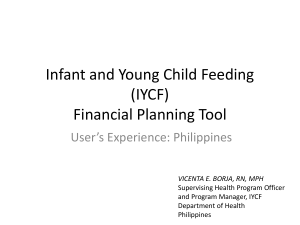The Intervention - Alive and Thrive
advertisement
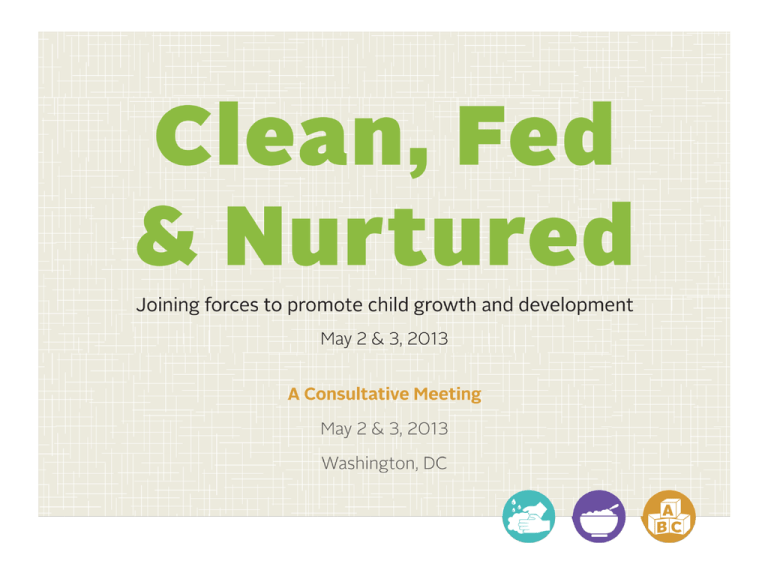
SESSION 2: Field Program Examples OBJECTIVES • Discover what types of integrated programs are feasible, especially at scale • Identify challenges and opportunities in integration OUTPUT • A list of challenges and a list of opportunities Communication Campaign for Reducing Stunting through IYCF + Handwashing Represented by Tina Sanghvi, Alive & Thrive, FHI 360 Bangladesh| Alive & Thrive, FHI 360 Program aims • Prevent stunting – Complementary feeding practices, especially nutrient-dense foods and animal source foods (existing program) – Handwashing to decrease infection, allow for better use of nutrients • Create intervention that WASH sector will pick up, including nutrition Areas of integration • WASH: – Wash hands with soap: • Before mashing child’s food • Before feeding child – Wash child’s hands • IYCF: – Feed right quantity, frequency – Feed 4 varieties of foods/day, focus on animal source foods • ECD: – [Responsive feeding] Constraints & Motivators • Make it convenient: HW station (water and soap) near feeding area • Shift social norms: Engage community members, make the practices seem normal, expected • Make health benefits credible: Stress protection from illness, germs The intervention Social mobilization guidelines Results from Trial Phase • Increased HW with soap before preparing food and feeding – Presence of handwashing station at feeding place increases HW at key times • Increased feeding of right quantity and frequency family food • Little impact on feeding 4 varieties of foods • Little interest from WASH colleagues MAMA, South Africa Mobile Alliance for Maternal Action Represented by Kirsten Gagnaire, Global MAMA South Africa| MAMA Program aims • Deliver vital health information to new and expectant mothers through mobile phones • Inform and empower low-income, expectant mothers who are at risk of complications and death during pregnancy and childbirth, and new mothers caring for their infants • Encourage care seeking behavior and regular clinic visits for immunizations and check ups Areas of integration • WASH: – Handwashing, food safety, safe water • IYCF: – Exclusive breastfeeding, appropriate complementary feeding • ECD: – Early stimulation, appreciation of developmental stages The intervention Results • Targeting health information to user’s gestational age or the age of child markedly increases acceptability of the service and user retention • Mothers appreciate the opportunity to connect with other mothers and feel empowered by the feeling of belonging to a community • Project implementation best done through consortium of partners: with technical and content expertise, access to clinical services, and experience in monitoring and evaluation Video: MAMA South Africa Mashup https://www.youtube.com/watch?v=2Rm Iwr0dpmE Educational intervention delivered through health services to improve child nutrition Represented by Rebecca Robert, Catholic University of America, visiting investigator with Instituto de Investigación Nutricional Peru | Instituto de Investigación Nutricional Johns Hopkins University Ministry of Health, Dept. La Libertad Program aims • Prevent stunting through improved feeding practices • Design and test educational intervention (not providing food) (cluster RCT) • Raise profile of nutrition in health centers, strengthen existing government health services without increasing personnel or costs Areas of integration • WASH: – [Wash hands, food, plate when preparing food] • IYCF: – Give thick puree – Give animal source foods (liver, egg, fish) • ECD: – Interactive (responsive) feeding: • • • • [Teach baby to eat] [Help baby to eat by himself] [Eat as a family] [If child won’t take food, wait, offer again] 3 Key Messages 1. At each meal give thick puree first 2. Add special food: liver, egg or fish 3. Teach your child to eat with love, patience, and good humor The intervention % Children Percentage of children with stunting by age and intervention group 18 16 14 12 10 8 6 4 2 0 0 3 6 9 12 Age in months 15 18 Intervention Control Results “Before, only the nutritionist gave messages. Now, we all give messages because we all speak the same language (of key messages), we all say the basic messages.” Early Stimulation and Nutrition Program in Rural Bangladesh Represented by Ivelina Borisova, Save the Children Bangladesh | Save the Children Program aims • Growth and development – Height for age – MUAC (mid- to upper-arm circumference) – Cognitive and language development • Sustainable and scalable model for improving stimulation and nutrition caregiving practices Areas of integration • WASH: – Wash hands with soap before feeding – Wash child’s hands before s/he eats • IYCF: – Feed a variety of nutritious foods, especially animal source foods – Feed with patience and good humor; encourage self feeding • ECD: – Give child affection, show love, every day – Play games every day and let the child play with playthings – Talk to and with your child; respond to child’s sounds The Intervention Save the Children & Department of Health and Family Planning Family Welfare Assistants Parent education support through home visits, community and satellite clinics Mothers of children 0-3 years 25 Child Development Card Child Development Card Results from first phase • Impact on growth and development – No impact on height for age (short intervention period,10 months) – Large impact on language and cognitive development (d=1.52 and 1.04 respectively) • Household practices – Improved caregiver-child interactions at home – Increased breastfeeding rates – Little impact on feeding animal source foods • Some impact on diarrhea rates Changing multiple behaviours Presented by Val Curtis, London School of Hygiene and Tropical Medicine Zambia| Nepal| Indonesia| India social biological biological executive setting setting reactive brain behaviour motivated body Evo-Eco model physical environment physical environment Settings • Kitchen makeover parties Manners Brand Nurture Video: SuperAma animation • http://www.youtube.com/watch?v=J3Fi IQQuiQw SESSION 3: Shared Indicators OBJECTIVE • To identify impact indicators of growth and development that could be used in a coordinated program OUTPUT • List of impact indicators SESSION 4: Household Practices OBJECTIVES • To review the household practices (or behaviors) critical to child growth and development, as currently articulated by each sector - ECD, Nutrition and WASH • To develop a (preliminary) comprehensive list of priority household practices for use across sectors • To identify feasible opportunities for program integration, promoting key household practices from each sector OUTPUT • A matrix of key behaviors by age cohort • Ideas for integrating key behaviors into sector programming • List of challenges to integration, with possible solutions SESSION 5: Future Actions OBJECTIVES • To identify specific opportunities for moving forward with collaboration to advance child growth and development • To allow participants to make a public commitment of resources to specific collaborative actions • To identify ways to share the spirit and outputs of this meeting with the broader community – the three sectors and the child health and education communities OUTPUT • List of potential collaborative actions, with names of people and/or organizations attached

